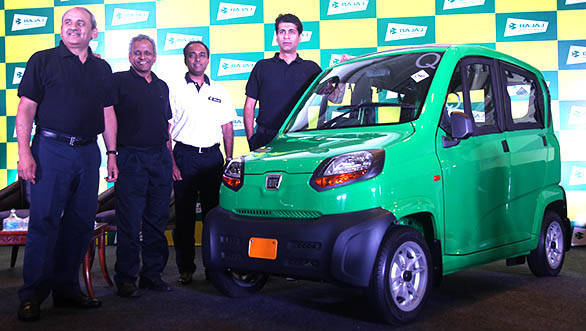Debating the quadricycle in India
The latest industry debate in India revolves around a very basic mode of transportation, the quadricycle. Ever since Bajaj Auto revealed the 'Qute' (that's one way to raise a debate), there has been an enormous amount of negativity directed at it. Some of it is warranted, some of it, I don't understand. The general anger is directed towards the issue of safety and the probable lack of it in the Qute. So far, the Qute hasn't gone through any safety tests anywhere in the world, or maybe it has, and the results haven't been declared yet. Whatever be the case, I do believe it is premature to assume the Bajaj Qute is unsafe.
That quadricycles have been deemed unsafe in general is an entirely different ball game. This also has nothing to do with being just a domestic issue, this is a globally accepted, tested and evaluated conclusion. Quadricycles offer significantly lower levels of safety and security compared to several other kinds of vehicles that ply on the same roads.
Quadricycles are categorised into light quadricycles L6e (speed limited to 45kmph and with engine capacities not exceeding 50cc) and heavy quadricycles L7e (max payload not exceeding 650kg in case of passengers and max power no more than 20PS). Technically, the Tata Magic and Magic Iris should have also been deemed as quadricycles if not for their engine displacements (600cc). That they make a paltry 11 horsepower is just shameful but that and other legalities allow them to escape the 'quadricycle' classification.
The general argument in favour of quadricycles has been that since they do not meet high powered requirements and are incapable of reaching high speeds, they are generally safer. The Euro NCAP also states on its website that these vehicles do not have to conform to the more stringent safety tests that apply to cars. However, quadricycles are more prone to severe damage and injury to passengers if they are struck by other vehicles, irrespective of the speed of the quadricycle. To this end, the Euro NCAP conducted its usual gamut of tests on four quadricycles as part of its safety campaigns in 2014. These were for both frontal and side impact tests and the test speeds were kept at 50kmph. The Renault Twizy managed to achieve six points out of 16 for frontal impact and seven points out of 16 for side impact and it was the best overall result they saw between the four quadricycles on test.
In these tests, all the quadricycles showed critical safety issues though the results were inconsistent and some did better than others. The Euro NCAP further goes on to advise that "Consumers, however, should note that quadricycles in general offer a significantly lower level of occupant protection than is offered by cars." So far , the Government is allowing the debate to arrive at a conclusion before allowing quadricycles to ply on Indian roads. The debates will also help frame policy and regulations that quadricycles will have to abide by. If the quadricycle is allowed in India, my issues will, of course, revolve around safety.
However, there are other issues I also foresee. One of these is that quadricycles will be allowed to ply on roads where higher speeds are deemed necessary. I'm referring to the expressways and other roads where only four-wheelers are allowed to ply. The rules set by the Government are convoluted but I'm all for regulating the flow of two- and three-wheelers on controlled highways. Question is, what happens when the quadricycles come into effect â€" will they be allowed to ply on these expressways, because they have four wheels, so technically you can't restrict them?
In India, the quadricycle is intended to replace three-wheelers used for public transport. It's expected then that the quadricycle will address and correct several issues that three-wheelers face. This has primarily to do with space and convenience. Three-wheelers in India presently are not completely enclosed structures and consequently, they are susceptible to the elements, a problem that a quadricycle is well equipped to correct. Second, there is hardly any additional space offered to passengers in a three-wheeler. A quadricycle will seat four, even five, since most Indian have learnt to squeeze in, and its boot will offer significantly more value to customers.

So I don't understand why the three-wheeler unions are set against the quadricycle. It's also expected that the quadricycle in India will be priced below Rs 2 lakh â€" that is a similar price to most three-wheelers. Rickshaw unions are claiming that their three-wheelers are more safe than any four-wheeler, but that is an entirely dubious claim. A quadricycle does have its benefits and where public transport is concerned, those benefits outweigh the drawbacks. I think  and adopt a more modern approach to public commuting.
Above all, the issue isn't really about quadricycles and their pros and cons. The issue here should be about policy and the framework that can be built for the safer existence of all involved. This does not have to apply to just quadricycles but to all areas of transport inclusive of quadricycles.
For more notes from the editor-in-chief, click here
.